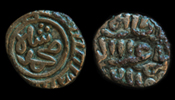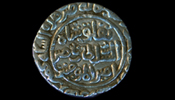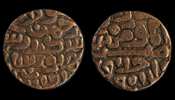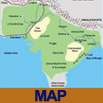|
|
|
|
SULTANS OF DELHI |
|
|
|
|
|
|
|
|
|
|
|
|
|
 |
|
Second Dynasty � The Khiljis (1290 - 1320 A.D, 689 - 720 A.H.)
Jalaluddin Feroz Khilji (1290 - 1296 A.D.) founded the Khilji dynasty, by defeating the descendents of Balban. Ala-uddin (nephew of Jalaluddin) succeeded him in 1296 A.D. General Malik Kafur, appointed Allauddin�s minor son Shihab-ud-din Umar as the successor. After Malik Kafur�s death, Shihab-ud-din dethroned and gave way to his brother Mubarak Shah to rule. Nasir-ud-din Khusro Shah was the last ruler of Khilji dynasty, after whom Tughluqs rose to power with the leadership of Ghiyas-ud-din Tughluq Shah � I.
|
|
|
Billon Jital
Obverse: In double circle: 'Muhammad Shah'
Reverse: 'Al-Sultan Al-Azam Ala-ul-din-wa-duniya' |
|
|
|
|
|
|
|
|
|
|
|
|
|
|
|
|
|
|
|
|
|
|
|
|
|
|
|
 |
|
Third Dynasty � The Tughluqs (1320 - 1414 A.D, 720 - 817 A.H.)
Ghiyas uddin Tughluq (1320 - 1325 A.D.) was originally a Karuna Turk, perhaps a mongol tribe settled between Sindh and Turkistan. His son Muhammad Shah Tughluq is known for his experimentation in coinage. He produced abundant gold coins, compared to any of his predecessors, executed fine calligraphy and issued number of fractional denominations. He added the gold dinar of weight 202 grains, compared to the standard weight of 172 grains. The silver Adlis weighed 144 grains.
|
|
|
Rupiya
Inner-circle: Tughluq Shah Al-Sultan Nasir Amir-ul-Mominin;
Margin: Zarb Haza Al-Sikka Ba Hazrat Dehli (Fi San Arba-wa-Ashrain-wa-satmaya). |
|
The coins struck at both Delhi and Daulatabad were curious and issued in his father�s memory. The Kalima appeared in most of his coinage, the titles were �The warrior in the cause of God�, �the trustier in support of the four Khalifs � Abu Bakr, Umar, Usman and Ali�. More than 30 varieties of billon coins are known so far.
Most wonderful of his coinage is the forced currency, having two scalable versions. He engraved �He who obeys the Sultan obeys the compassionate�, inscriptions were even engraved in Nagari legend.
His successor Feroz Shah Tughluq (1351 � 1388 A.D.) inherited full treasury, at least six different types were known, they had traditional theme of inscribing the name of Khalifs. The obverse inscribed �the right hand of the commander of the merciful� and �the deputy of the commander�. The later appeared until Bahlol Lodi�s reign.
|
|
|
|
|
|
|
|
|
|
|
|
|
|
|
|
|
|
|
|
|
|
|
|
|
|
|
|
|
Fourth Dynasty � The Sayyids (1414 - 1451 A.D, 817 - 855 A.H.)
Tughluq�s incompetent successors could not handle the Situation & a new dynasty of Sayyids came over in 1414 A.D.
|
|
|
|
|
|
|
|
|
|
|
|
|
|
|
|
|
|
|
|
|
|
|
|
|
|
|
|
|
|
 |
|
Fifth Dynasty � The Lodis (1451 - 1526 A.D, 855 - 932 A.H.)
It was the last ruling families of Delhi Sultanate. Bahlol Lodi (1451 - 1489 A.D.) founded the Lodi dynasty. Nizam Khan son of Bahlol Lodi, Succeeded his father with the title �Sikandar Shah� (1489 � 1517 A.D.). Afghan nobles put Sikandar�s eldest son Ibrahim Lodi on throne in 1517 A.D.
Ibrahim�s uncle Daulat Khan invited Babur of Afghanistan to fight against Ibrahim. Babur in 1526 A.D., fought with Ibrahim on famous battle field of Panipat & defeated him, putting an ultimate end to Sultanate after which he took up the title of �Badshah�.
|
|
|
Copper Tankah
Obverse: Al-Mutawakil-ur-Rehman Sikandar Shah Bahlul shah Sultan
Reverse: Fi Zaman-ul-Mominin Amir-i-Khilafat Khildat 901 A.H. |
|
|
|
|
|
|
|
|
|
|
| |




